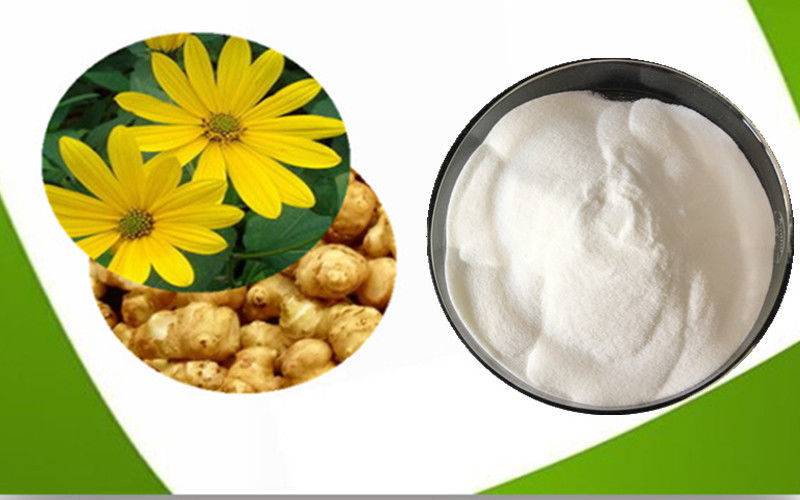Study on Jerusalem Artichoke Inulin Powder
As a renewable resource, inulin is extremely viable. c is abundant in the tubers, and due to the diversity of its biological activities, research on inulin has attracted more and more attention.
1.Jerusalem Artichoke
1.1 Introduction to Jerusalem Artichoke
Jerusalem Artichoke is a perennial, persistent herb of the sunflower genus of the Asteraceae family, and is a cultivated species with a rich history of forming underground tubers. The underground tubers are rich in inulin (fructans) [1].
Native to North America, the Jerusalem Artichoke was introduced to Western Europe in 1607 and was used as a major source of sugar in the diet for a long time until it was replaced by the potato in the mid-18th century. Today, Jerusalem Artichoke is consumed in much lower quantities than it once was in the United States and Europe. Jerusalem Artichoke tubers have a nutty flavor and a sweet taste. After spreading for some time in Europe, the Jerusalem Artichoke tuber became an important source of edible carbohydrates. [2].

1.2 Growth Characteristics of Jerusalem Artichoke
Jerusalem Artichoke is very resilient: it can grow wherever there is moisture and sunlight. Even in desert areas, as long as the root tuber is not exposed, it can grow. As a species, it is very competitive, and it will quickly shade the soil surface and create a resource-seeking area, thus inhibiting the growth of other species[3] . Jerusalem Artichoke has a high reproduction rate: Jerusalem Artichoke has low requirements for natural conditions such as climate and soil, and can be planted once and reproduced forever. No pests and diseases: Because the growth of the Jerusalem Artichoke and no need to apply chemical fertilizers and spraying pesticides, neither pollution, and no pests, Jerusalem Artichoke nutrient-rich, contains inulin, polypentose, starch and other effective substances, and its wide range of uses, tubers can be used for food and medicinal purposes, it is a very potential for development of green vegetables, health care for the human body is very beneficial. Short growing period: the general growth cycle of Jerusalem Artichoke is about half a year[4] .
1.3 Distribution and Application of Jerusalem Artichoke
As a niche crop, Jerusalem Artichoke is mainly grown in North America and northern Europe. However, there are reports of cultivation in China, Korea, Egypt, Australia, and New Zealand. The Yellow River Delta, as the intersection of the "Shandong Peninsula Blue Economic Zone" is a key area for development in Shandong Province, with 8 million mu of saline and alkaline land awaiting development and improvement.
Whereas in most crops the carbon source is stored in the form of starch, in Jerusalem Artichoke, a fructose polymer, is the carbon source. Only a small percentage of plants can accumulate enough extractable inulin, which makes the value and function of Jerusalem Artichoke very different from that of most crops, and Jerusalem Artichoke of plant origin can be processed or modified to provide raw material for a wide range of industrial production.6].
It is summarized that there is a large and growing body of literature related to Jerusalem Artichoke [7]. The properties of Jerusalem Artichoke in the food industry processing [8]: (1) weak water absorption, which can reduce the food moisture deterioration; (2) high thermal stability, can withstand higher temperatures; (3) pure sweetness, refreshing than sucrose.
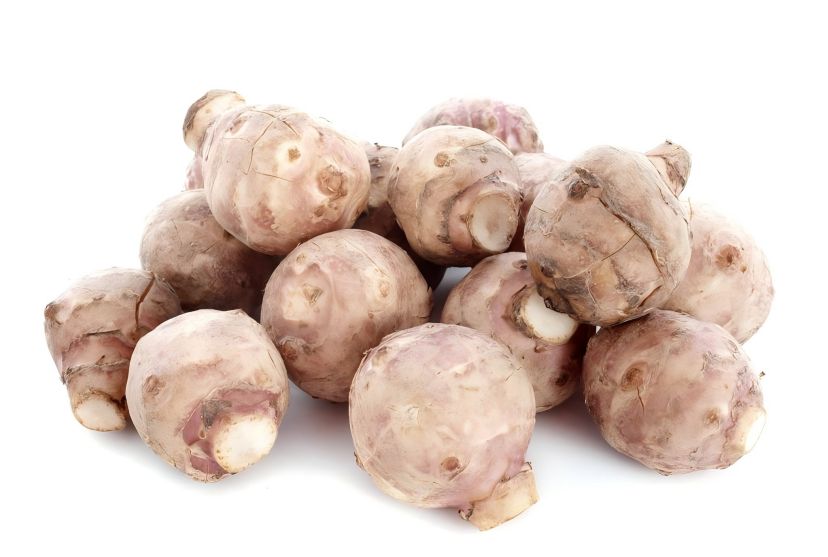
Jerusalem Artichoke is a versatile crop that provides ingredients for many types of food. It can be used as a vegetable, a feedstuff, a raw material for the production of inulin and bioethanol. Depending on the application, the plant can be an annual or a perennial, and all parts of the plant can be utilized as a raw material for food, feed, industry or energy.
The demand for two products derived from Jerusalem Artichoke, inulin and bioethanol, has increased dramatically in the 21st century because of their ability to help solve health, energy, and environmental problems facing society[9] . Inulin can be used to treat obesity and diabetes, while bioethanol can help reduce the use of non-renewable petroleum resources and improve air quality. As technology develops, the potential applications of inulin will continue to be exploited. Meanwhile, global climate change will alter the agricultural landscape in the 21st century.
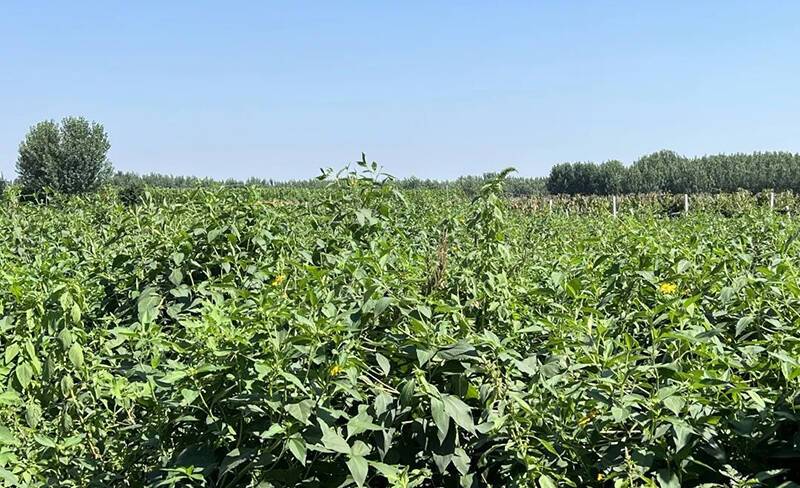
1.4 Prospects for the Utilization of Jerusalem Artichoke
Jerusalem Artichoke is a versatile crop that provides ingredients for many types of food. For example, it can be used as a vegetable, as feed, and as a raw material for the production of inulin and bioethanol. Depending on the application, the plant can be annual or polyannual, and all parts of the plant can be utilized as a raw material for food, feed, industry, or energy. The price of its by-products will economically determine whether or not the plant is superior to other crops. For example, when the tubers are used to produce inulin, the straw can be used for feed, energy production, or to make low-quality paper and fiberboard. Because of their bifidobacterial effect, extracts of inulin tubers have great potential as additives to animal feed. Currently, inulin and oligofructose are mainly extracted from chicory tubers, and although their animal health benefits are less well known than their beneficial effects on humans, they are still added to livestock feed.
Jerusalem Artichoke is relatively inexpensive to grow compared to other energy crops because it usually requires low inputs in terms of irrigation, fertilizer and pesticides. Demand for two products derived from Jerusalem Artichoke - inulin and bioethanol - has increased dramatically in the 21st century because of their ability to help solve health, energy and environmental problems facing society. Inulin can treat obesity and diabetes, while bioethanol can help reduce the use of non-renewable petroleum resources and improve air quality. Due to its unique health benefits and many food processing applications, it has been hailed as a "food of the 21st century" with great prospects for development [10].
2. Inulin Powder
2.1Introduction to Inulin Powder
Inulin is widely distributed in nature. It is a plant polysaccharide stored as a sugar reservoir in many plants. Inulin is found in more than 35,000 species of plants, such as inulin, chicory, onion, garlic, snowberry tuber rye, blueberry, tomato, etc. Among them, inulin tuber is the main source of inulin production in China. The main source of inulin is plants, but it can also be obtained from some bacteria and fungi, and the content of inulin in some common plants is shown in the table below [11]:
Table1-1 Inulin Content in Plant (Wet Weight)
Plant Name | Inulin Content (%) |
maize | 1~4 |
onion (Allium cepa) | 2~6 |
leeks | 3~ 10 |
asparagus | 10~ 15 |
chicory | 13~ 18 |
Jerusalem artichoke | 14~ 17 |
molasses | 9~ 16 |
bananas | 0. 13~0. 17 |
Taraxacum mongolicum | 12~ 15 |
Solomon's ginseng | 4~ 11 |
dahlia | 15~20 |
Inulin, as an extract of the natural plant inulin, has been approved by the FDA to enter the U.S. market. Studies have found that inulin has many good functional properties, and it is easy to obtain and has a large storage capacity. Among many commercialized oligosaccharides, only inulin and oligofructose have been recognized as effective additives by the FDA and other authoritative agencies [ 12] . At present, there are Belgian ORAFTI, WARCOING, Dutch COSUN, and Qinghai Weide Company which can process inulin in large scale industrially [ 13]. There is a huge potential for the development of the application value of inulin, and the research of inulin is getting more and more attention from people.
2.2 Physicochemical Properties of Inulin Powder
Inulin, a polymer of D-fructose, is a chain polysaccharide of D-fructose linked by a β(2-1) glycosidic bond, with D-glucose linked at the end of the molecule by a β(1-2) bond. The molecular formula of inulin has a GFn structure (G: glucose group, F: fructose group, n: number of units of fructose group). The degree of polymerization of inulin ranges from 2-60, and the average molecular weight is around 5500 [14].
Inulin is a white or milky white amorphous powder, it is a very good water-soluble dietary fiber, with a solubility of 6% at 10℃, and the solubility increases after heating, about 35% at 90℃. As the concentration increases, the viscosity of inulin solution increases with it. The gel formed by inulin is very smooth, similar to fat or cream[ 15] . The viscosity of inulin increases with decreasing temperature, providing the desired taste and texture when replacing sugars or fats, as well as controlling the consistency of cakes and desserts based on the performance of viscosity properties, and inulin can be used as a fat replacer to provide a rounded and smooth texture and flavor.
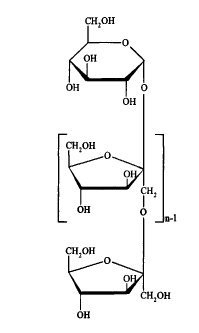
The viscosity of aqueous inulin solutions of different concentrations is also different. When the concentration is 1%-10%, the viscosity gradually increases when the content of inulin increases, and the relationship can be seen in the following table. However, as the concentration continues to increase, the viscosity of inulin will gradually become thicker, and inulin will combine with water to form a gel, which is very similar to fat. When the concentration is increased to 50%, the gel becomes very solid [16].
Table 1-2 Viscosity of inulin in water
Inulin | (%) | Viscosity (11℃) |
2 | 1.25×10-3 Pa.s | |
4 | 1.35×10-3 Pa.s | |
6 | 1.70×10-3 Pa.s | |
8 | 1.80×10-3 Pa.s |
Inulin is slightly sweet, without any bad flavor, mild and non-irritating, and the sweetness of inulin is also affected by the degree of polymerization. Generally, commercially available inulin shows sweetness because of the presence of mono- and disaccharides in the product, but long-chain inulin itself does not have sweetness. Inulin can be used as a humectant in food because of its hygroscopic properties. It is soluble in water, the ability to bind water is about 2:1, and the solubility increases with the increase of temperature, taking baked goods as an example, inulin can delay its water evaporation, thus preventing the product from deteriorating, and maintaining or extending the shelf life of the product. 10% of the aqueous solution of inulin is pH neutral, the melting point is 178 ℃ , the solubility of 10 ℃ is 6%, and 90 ℃ is 35% [ 17].
Inulin has good stability to heat, inulin is chemically stable at high temperatures and pH>4, with a small amount of decomposition when pH<3.7.
2.3 Functions and Applications of Inulin Powder
(1) As Dietary Fiber to Prevent Constipation
As a dietary fiber, inulin powder is an effective prebiotic for humans. The value of inulin in the human diet and in animal feeds is attributed to its prebiotic activity in the large intestine. Probiotics have been an important dietary component for thousands of years. However, it was not until the early 1970s that the term probiotic came to be used in its current definition, i.e., an organism or substance that has a balancing effect on the flora in the colon. The β-(1-2)-glycosidic bond linking fructose in inulin cannot be cleaved by mammalian digestive enzymes, so it reaches the colon as an intact molecule. Approximately 85% of ingested inulin reaches the colon, where it serves as a fermentation medium for colon flora.
Inulin selectively stimulates the growth of Bifidobacteria and Lactobacillus, whereas other typical sugars such as starch or pectin do not have this effect. Inulin is not utilized by microorganisms in the stomach and small intestine of humans and animals, but mostly reaches the large intestine in its intact form, where it can selectively stimulate the growth of one and a few species of intestinal flora, as found by Ellegard et al. who found that inulin is fermented mainly in the colon of humans and animals. After reaching the large intestine, inulin selectively promotes the growth of beneficial bacteria, such as bifidobacteria and lactobacilli, and thus inhibits the growth of harmful bacteria, which is beneficial to the health of the host [18]. Kieessen et al. and Roberfriod et al. have found that inulin significantly promotes the growth of beneficial bacteria such as lactobacilli and bifidobacteria, and decreases the number of harmful bacteria such as bacillus anthropomorphus, e.g., E. coli, and clostridium difficile, in the intestinal tract of animals. Inulin can stimulate intestinal peristalsis, increase the wetness of feces and improve the intestinal environment, thus preventing constipation [19].
As a prebiotic, inulin can be widely used in dairy products to increase the proliferation of lactic acid bacteria and bifidobacteria and improve the nutritional and health functions of the products. In addition, as dietary fiber, inulin can be used as the raw material and carrier of health food for constipation patients, and can even be used as auxiliary treatment for patients. At the same time, inulin in the human body, can absorb water by itself, into a high viscosity colloid, prolong the gastric emptying time, increase the human body's sense of satiety, which can reduce the eating, and then reduce the absorption of nutrients, so as to achieve the prevention of obesity and weight loss [20].
(2) Promotion of Mineral Absorption
Osteoporosis is a disease characterized by a decrease in bone mass and density, which causes the human skeleton, especially in postmenopausal women, to become weak and prone to fractures. It is a growing global problem that can be improved with a better diet. Calcium is a key factor in measuring bone strength. By optimizing peak bone mass in early adulthood and minimizing bone loss after menopause, the risk of hip fracture can be significantly reduced. Improving calcium nutrition during the period of bone growth is essential and can reduce hip fracture rates in later life by about 50% [21].
In the human intestine, the fermentation of inulin produces short-chain fatty acids (SCFA) such as acetic acid, propionic acid, and butyric acid, which lower the pH in the intestine and increase the solubility of metal ions.Wang. Y., T. Zeng, et al. (2010) showed that fructooligosaccharides were effective in increasing the apparent absorption of calcium, magnesium, and iron, and significantly increased the hepatic zinc level and the femoral magnesium level, and that fructooligosaccharides counteracted the harmful effects of phytic acid. and that fructooligosaccharides counteracted the harmful effects of phytic acid. Therefore, when seaweed and inulin are used together, inulin can promote the absorption of calcium, magnesium, iron, zinc and other minerals in seaweed, and play a role in preventing and treating osteoporosis. This physiological function can be applied in the fields of food, health care and medicine to supplement the deficiency of trace elements in human body [22].
(3) Regulation of Blood Sugar
Diabetes mellitus means that sugar in the blood is not well absorbed and utilized by the cells. Type I diabetes mellitus is caused by the pancreas failing to secrete enough insulin, mostly due to genetic factors; non-insulin-dependent diabetes mellitus, i.e., type II diabetes mellitus, is caused by the failure of human cells to effectively produce insulin, which is related to obesity, over-nutrition, and excessive intake of dietary fats and sugar, etc. Inulin plays a role in reducing blood glucose concentration and promoting cellular uptake of glucose in type I diabetes mellitus. Inulin plays a role in reducing blood glucose concentration and promoting cellular uptake of glucose in type I diabetes, and in supplementing the body's insulin in type II diabetes.
It is found that inulin powder has a two-way effect on the regulation of blood sugar, on the one hand, it can lower the blood sugar level of diabetic patients with high blood sugar, and on the other hand, it can raise the blood sugar level of patients with low blood sugar. Inulin can inhibit the degradation of ingested fat by fat degrading enzymes, and form complexes with fat, which can be discharged with feces in time.
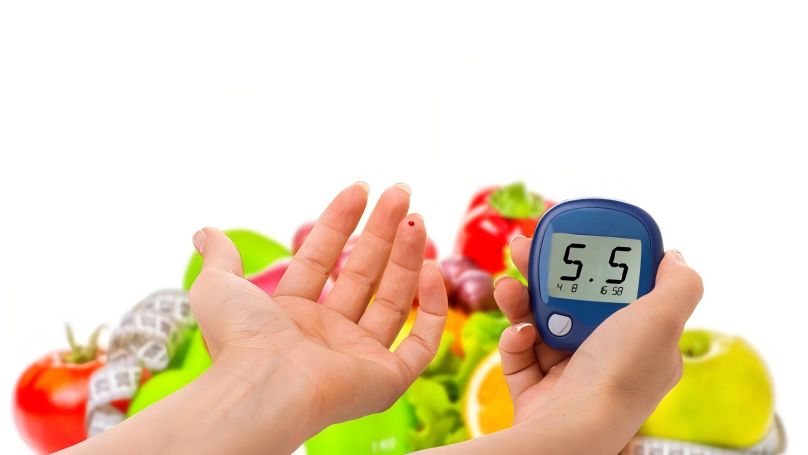
The hypolipidemic effect of inulin powder is mainly manifested in its ability to lower the levels of triglycerides and cholesterol in the blood, reduce the concentration of LDL in the body without affecting the concentration of HDL, and increase the ratio of LDL/HDL[23] . Nowadays, inulin is recommended in the diet to combat diabetes and obesity. However, while consuming inulin on a daily basis may be monotonous, foods containing inulin are also healthful. For example, in a range of food applications focusing on weight loss, health and diabetes treatment, inulin has been incorporated into butter, jams, beverages and other foods for people with diabetes.
(4) Regulation of Blood Lipids
Inulin helps maintain a healthy cardiovascular system and may reduce the risk of heart disease. A key factor in this is the maintenance and improvement of lipid composition by reducing triglyceride levels, as well as lowering cholesterol and homocysteine levels [24]. Patients with moderate hyperlipidemia are more likely to have positive outcomes than volunteers with normal lipid levels or non-insulin-dependent diabetes mellitus. Inulin-based fructose additives work by reducing the amount of lipogenesis in the liver and lowering the concentration of lipids in the blood.
Inulin has an expanding market in the food industry as a low-calorie sweetener, fat substitute, and thickener and filler. In addition, inulin can be converted into a range of compounds for the food and non-food industries. Different chain lengths of inulin and oligofructose, fructose are suitable for different food industries, while higher purity inulin and some of its derivatives have medicinal and medical values [25]. Chemical products obtained from the processing of inulin include alcohols, polymers, epoxides and resins, which also have many industrial uses, such as plasticizers, surfactants, binders and emulsions.
Table1-3 Potential Applications of Inulin Derived from Jerusalem Artichoke
Chemical products | appliance |
Inulin Probiotics | food ingredients |
Inulin Dietary Fiber | Low calorie fiber/bulking agent and thickening |
Inulin Raw Material | Low-calorie foods instead of fat |
Inulin Raw Material | Sweeteners/low calorie sugar substitutes |
Prebiotic Oligofructose | food ingredients |
Fructose (crystalline) | Numerous food industries |
Inulin Probiotics | food ingredients |
Inulin Dietary Fiber | Low calorie fiber/bulking agent and thickening |
Inulin Raw Material | Low-calorie foods instead of fat |
Inulin Raw Material | Sweeteners/low calorie sugar substitutes |
Prebiotic Oligofructose | food ingredients |
Fructose (crystalline) | Numerous food industries |
Inulin Amino Acids | pharmaceutical |
o-(Cyanoethyl)inulin | pulp |
o-(3-Amino-oxopropyl)pyrethrum | Emulsifiers and surfactants |
o-(Carboxyethyl)inulin | Inhibition of calcium carbonate precipitation |
o-(3-oxime-3-aminopropyl) | Chemical Uses |
o-(Aminopropyl)inulin | cleaning agent |
o-(Aminopropyl)inulin derivatives | Industrial use including cosmetics |
stearamide | Surfactants for use in detergents |
N-Carbomethylaminopropyl inulin | Chelating agents for detergents |
Cyclic inulin hexasaccharide derivative | For Cosmetics |
Alkoxylated inulin | stability performance |
Inulin Phosphate | thermoreversible gel |
complexing agent | heavy metal precipitation |
Application of Inulin Powder in the Food Field:
Dairy products: adding inulin to infant milk powder, pure milk, flavored milk, and various milk powders can solve the problems of middle-aged and old people and children who are prone to fire and constipation when supplementing nutrition; adding inulin to fermented dairy products can provide nutrients to the live bacteria in the products, and enhance the action of the live bacteria in time to extend the shelf life of the products [26].
Candy cakes: a variety of soft candy, hard candy, chocolate, etc., can enhance the color of the product, improve the crispness, conducive to expansion.
Desserts: puddings, jellies, gelatos, etc. for more lubrication and improved flavor.

Beverages: carbonated beverages, tea beverages, nutritional beverages, juice beverages, powdered beverages, etc., to increase the smooth taste and reduce the calorific value of the food, but also to extend the shelf life of the product.
Health food: Various kinds of health wines and health food, especially those for children and the elderly, can prevent the precipitation of in-soluble substances in wines, improve clarity, enhance the flavor of wines, and make the taste of wines mellow, sweet and refreshing [27].
As a renewable resource, inulin is extremely viable. Jerusalem Artichoke is abundant in the tubers, and due to the diversity of its biological activities, research on inulin powder has attracted more and more attention.
Reference:
[ 1] Zu-Xin Liu, Progress of research on inulin as an energy plant, Journal of China Agricultural University, 2012 ,(06): 122-132
[2] Ling-Yun Wei, Jian-Hua Wang, Xiao-Dong Zheng, et al. Review and Prospect of Inulin Research, Food and Fermentation Industry, 2005 ,(07): 81-85
[3] Uzhina, Zhu Tiexia, Yu Yongqi et al, Current research status and development potential of chrysanthemum, Grass Science, 2013, (08): 1295-1300
[4]Malmberg A,Theander O, Differences in chemical composition of leaves and stem in Jerusalem artichoke and changes in low-molecular sugar and fructan content with time of harvest,Swedish Journal ofAgricultural Research, 1986, 16( 1):7-12
[5] Guo Hongtao, Guo Yanyin, Progress in the development and utilization of chrysanthemum resources, Shandong Agricultural Science, 2011, 11: 69-72
[6] Xiangyang Ge, Weiguo Zhang, Selection and breeding of Aspergillus niger strains for alcohol production from synchronized saccharification and fermentation of chrysanthemum, Journal of Food and Biotechnology, 2006, 25(2): 83-87
[7] W.J. Yuan, X.Q. Zhao, F.W. Bai, Screening of ethanol-producing strains for one-step fermentation of Jerusalem artichoke and study of enzyme-producing conditions and enzymatic properties, Bio-Processing Process, 2008, 6(6): 25-29
[8]Liu Z X,Han L P,Steinberger Y, Genetic variation and yield performance of Jerusalem artichoke germplasm collected in China, Agricultural Sciences in China,2011, 10(5):668-678
[9] Radovanovic A, Stojceska V, Plunkett A, et al. The use of dry Jerusalem artichoke as a functional nutrient in developing extruded food with low glycaemic index, Food Chem, 2015,.177:81-88
[ 10]Wang L, Xue Z, Zhao B, et al. Jerusalem artichoke powder: a useful material in producing high-optical-purity l-lactate using an efficient sugar- utilizing thermophilic Bacillus coagulans strain, Bioresour Technol, 2013, 130:174-180
[ 11] Xiao Zaijun, Zhu Dinghe, Wang Xiaohong et al. Research on the extraction process of inulin from chrysanthemum, Modern Food Science and Technology, 2013 (02):315-318
[ 12] Tang Feng, Yang Wu, Wang Li, et al. Research on the functional properties of inulin, Food Industry Science and Technology, 2010(05): 318-320
[ 13]Franck A, Prebiotics stimulate calcium absorption: a review, Food Australia, 2005, 57( 12): 530-532
[ 14]Coudray C,Bellanger J,CastigliaDelavaud C,et.al,Effect of soluble or partly soluble dietary fibres supplementation on the absorption and balance of calcium, magnesium, iron and zinc in healthy young men, European Journal of Clinical Nutrition, 1997,51(6):375-380
[ 15] Beylot M, Effects of inulin-type fructans on lipid metabolism in man and in animal models, British Journal ofNutrition,2005,93( 1):163-168
[ 16] Luo Denglin, Liu Juan, Xu Wei et al, Gel characteristics of inulin under acidic conditions, Journal of Agricultural Machinery, 2014(05): 185-190
[ 17] Zeng Xiaoyu, Luo Denglin, Liu Shengnan et al, Research status and development prospect of inulin, China Food Additives, 2010 , 4:222-227
[ 18]Pourfarzad A, Habibi N M, Haddad K M, et al. Serish inulin and wheat biopolymers interactions in model systems as a basis for understanding the impact of inulin on bread properties: a FTIR investigation,J Food Sci Technol, 2015, 52( 12):7964-7973


 English
English French
French Spanish
Spanish Russian
Russian Korean
Korean Japanese
Japanese